I want to share my Taro Rice Recipe (芋头饭), a specialty dish not meant to be cooked daily but for certain festive occasions due to its richness. It is so delicious that it can be served as a stand-alone dish. Additionally, it pairs exceptionally well with Bak Kut Teh, the signature pork soup with meat popular in Malaysia and Singapore.
Taro rice (芋头饭) is an easy one-pot meal that is incredibly delicious. The fragrance from the ingredients is enough to make you drool!
Here are the detailed steps of the taro rice recipe.
Note: The root vegetable taro is called 芋头 in Chinese. Since yam is also called 芋头, it is commonly translated as yam rice. Both mean the same dish, 芋头饭.
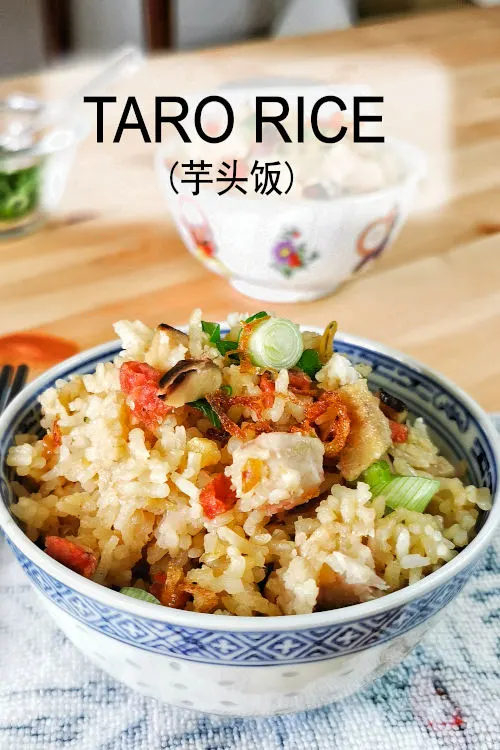
Note: This post may contain affiliate links. Please read my privacy policy for more info. I may receive commissions for purchases made through links in this post. As an Amazon Associate, I earn from qualifying purchases.
1. Prepare the ingredients
Besides taro, it is prepared with shitake mushrooms, Chinese sausage, and fried shallots. These ingredients are made with high umami, and the rice soaks up all the flavors like a sponge, making it incredibly delicious.
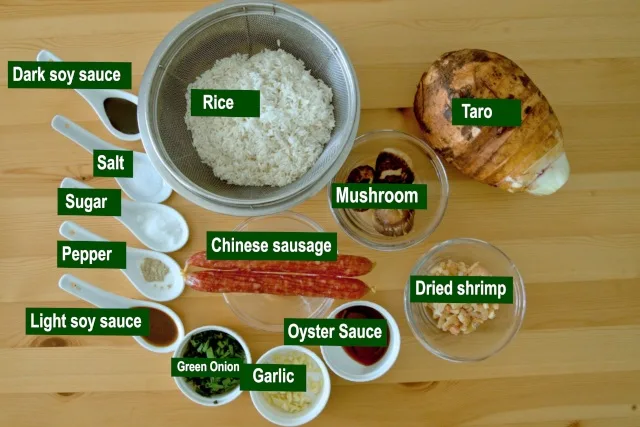
a. Rice and taro
- Rinse the rice several times with water, then drain and set aside.
- Cut off the fibrous surface near the taro root with a sharp knife until the soft flesh is revealed. Then, peel off the skin of the reminder parts with a vegetable peeler. After that, wash the taro and cut it into small cubes.
b. Other ingredients
- Soak the dried shiitake mushrooms in water until soft, remove the stem, and cut them into small cubes.
- Similarly, soak the dried shrimp in water until soft, squeeze out as much water as possible and chop it coarsely if they are too big. Finally, transfer the dried shrimp to a paper towel to absorb as much water as possible. This step prevents the dried shrimp from spluttering in the oil during frying.
- Cut one stalk of spring onion into thin slices.
- Coarsely chop two cloves of garlic.
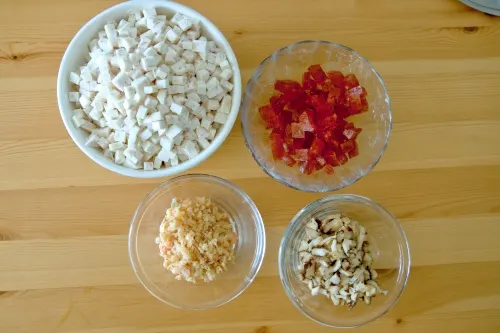
- Place the Chinese sausage (lap cheong) in boiling water for 30 seconds, then remove. The sausage casing will expand and separate from the sausage. You can slip out the casing easily. After removing the outer casing, cut the Chinese sausage into small cubes.
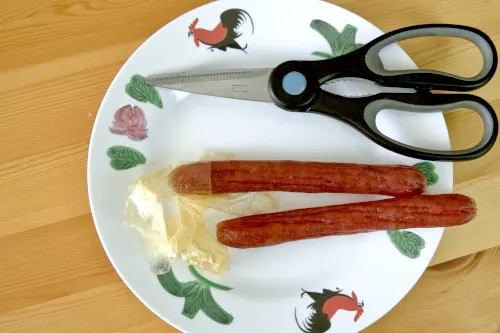
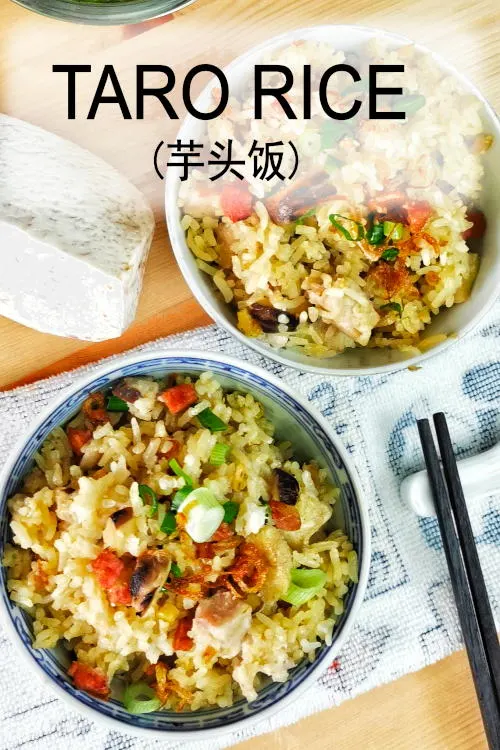
2. Prepare the shallot oil
I have a detailed article on how to prepare shallot oil. I usually make a batch of shallot oil for various dishes. Here are the steps in brief:
- Peel and wash the shallots.
- Slice the shallots into thin slices.
- Loosen up all the shallot rings.
- Heat some vegetable oil in a pan to medium heat.
- Place the shallot in the oil and fry it gently until golden brown.
- Let the crispy shallot pass through a wire mesh strainer to prevent it from continuing to cook in the hot oil.
- Return the crispy shallots to the oil and let them suspend in the oil. This method will keep the shallots from the air and remain crisp. You can also store the shallot separately in an airtight container.
3. Fry all the ingredients
- Heat three tablespoons of oil in the wok to fry the taro pieces until they turn color. Note that the taro will not turn golden brown despite prolonged frying. Remove the yam pieces and drain in a colander. You can use the remaining oil to cook the rest of the ingredients.
- Stir-fry the taro until it starts to turn fragrant. Drain in a colander and remove the excess oil in the wok.
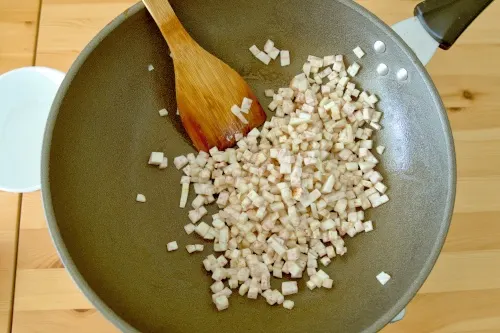
- Add the dried shrimp and saute the remaining oil over low heat until aromatic.
- Include the chopped garlic, followed by the mushrooms and the Chinese sausage.
- Stir-fry the ingredients over medium heat until aromatic. Then remove it from the wok.
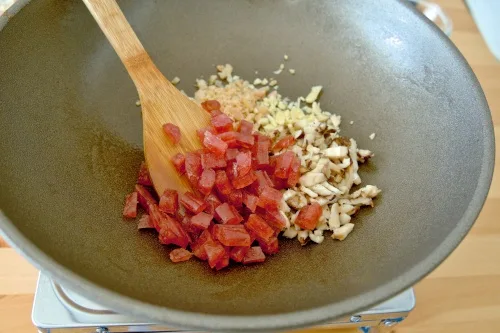
- Add a tablespoon of shallot oil to the wok to stir-fry the rice over low to medium heat for a minute or until it becomes dry and sticky.
4. Season the taro rice
- Return the dried shrimp, garlic, mushrooms, sausages, and taro to the wok and mix with the rice thoroughly.
- Season the rice with salt, sugar, white pepper powder, light soy sauce, and oyster sauce.
- Add a suitable amount of dark soy sauce to adjust the color according to your preference.
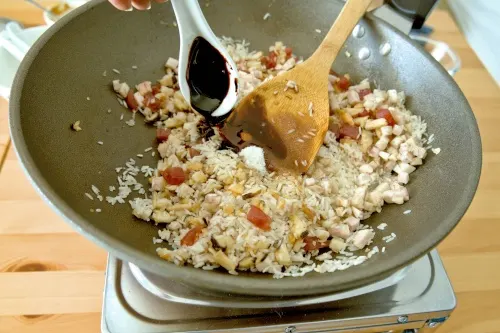
Note: Some recipes include pork belly slices, ground pork, and dried cuttlefish. However, I will leave them out since the ingredients I use have enough flavor for this taro rice recipe.
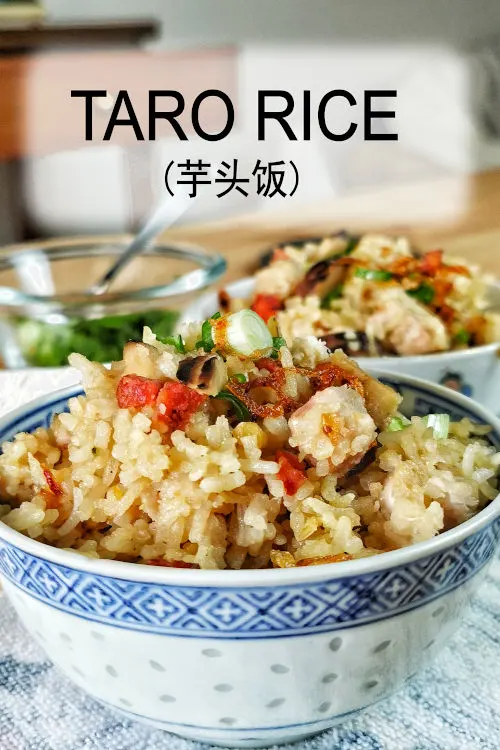
5. Cook the rice with the electric rice cooker
- Pour the rice mixture into an electric rice cooker.
- Add sufficient liquid to cook the rice. I use the water to soak the dried shrimp and mushrooms as part of the liquid to cook the rice to enhance the flavor. The amount of liquid required should be slightly more than cooking regular white rice, as the rice is drier after frying. Therefore, the liquid is sufficient when it is 1 cm above the surface of the rice mixture. You can substitute part of the liquid with chicken stock if you want a richer flavor. (The final amount of water I use is 450ml for 300g of rice, which has been drained in a colander.)
- Add some thinly sliced spring onions and fried onions to the rice.
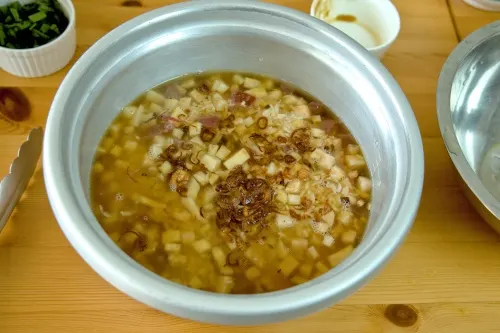
- Switch on the rice cooker.
- When the yam rice is cooked, rest for ten minutes before opening the lid.
- Sprinkle more spring onions and fried shallot on the rice before serving.
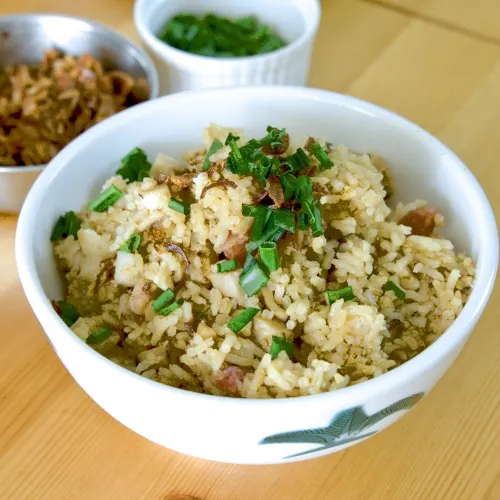
Other taro recipes that might interest you :
If you enjoy this taro rice recipe, you might also want to try other taro recipes featured on this blog:
- Taro cake is a savory dessert popular for breakfast or afternoon tea and a favorite during the festive season.
- Yam ring is a popular dish served in Chinese restaurants in Malaysia. Not surprisingly, it is made with taro!
- Taro puff is truly delicious. It’s savory and can often be found in Dim Sum stores, which is a savory delight.
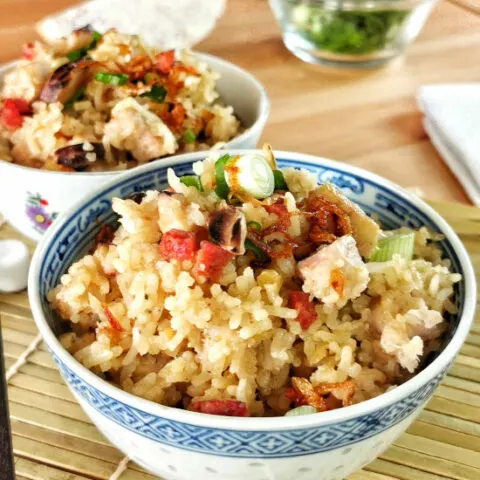
Taro rice recipe
Taro rice (芋头饭) is an easy one-pot meal that is incredibly delicious. The fragrance from the ingredients is enough to make you drool!
Ingredients
Ingredients A
- 300g rice
- 30g dried shrimp
- 3 medium-size dried shiitake mushrooms
- 1 tbsp shallot oil
- 300g taro (weight after peel and cut)
- 1 stalk spring onion
- 1 Chinese sausage
- 2 cloves of garlic
- Vegetable oil for frying
Ingredients B (seasoning)
- 1/2 tsp salt
- 1 tsp sugar
- 1/4 tsp white pepper
- 1 tsp light soy sauce
- 1 tbsp oyster sauce
- 1/2 tsp dark soy sauce
Instructions
Preparation
- Rinse the rice with water, then drain and set aside.
- Peel and cut the taro and cut it into small cubes.
- Soak the dried shiitake mushrooms in water until soft, remove the stem, and cut them into small cubes.
- Soak the dried shrimp in water until soft, chop it coarsely and drain on a paper towel.
- Cut one stalk of spring onion into thin slices.
- Coarsely chop two cloves of garlic.
- Place the Chinese sausage (lap cheong) in boiling water for twenty seconds, then remove the casing. Cut into small cubes.
Cooking
- Fry the taro pieces with some oil until they turn color. Drain in a colander.
- Stir-fry the dried shrimp, garlic, mushrooms, and Chinese sausage with some oil over low heat until aromatic. Then remove it from the wok.
- Add a tablespoon of shallot oil to the wok to stir-fry the rice over low to medium heat for a minute.
- Return the dried shrimp, garlic, mushrooms, sausages, and taro to the wok and mix with the rice thoroughly.
- Season with ingredients B.
- Pour the rice mixture into an electric rice cooker.
- Add sufficient liquid to cover the rice 1cm above the surface.
- Add some thinly sliced spring onions and fried onions to the rice.
- Switch on the rice cooker.
- When the rice is cooked, sprinkle more spring onions and fried shallot on top of the rice before serving.
Recommended Products
As an Amazon Associate and member of other affiliate programs, I earn from qualifying purchases.
Nutrition Information:
Yield: 3 Serving Size: 1Amount Per Serving: Calories: 466Total Fat: 16gSaturated Fat: 3gTrans Fat: 0gUnsaturated Fat: 12gCholesterol: 35mgSodium: 1025mgCarbohydrates: 70gFiber: 7gSugar: 3gProtein: 9g
This data was provided and calculated by Nutritionix on 1/8/2022

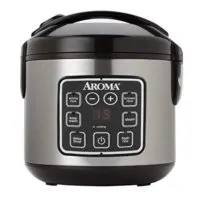
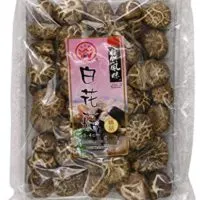
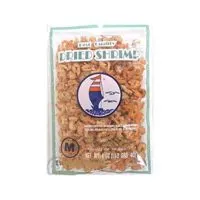

Pauline
Wednesday 3rd of August 2022
I've tried cooking the taro rice. Very successful & very yummy. Thank you so much for giving us this lovely receipe. By the way, I did add some belly pork to the rice. It's so so delicious. Tqvvm.
KP Kwan
Wednesday 3rd of August 2022
Hi, this is KP Kwan. I am happy to see you in this comment area, as you have read through my recipe. I am glad to reply to any questions and comments as soon as possible.